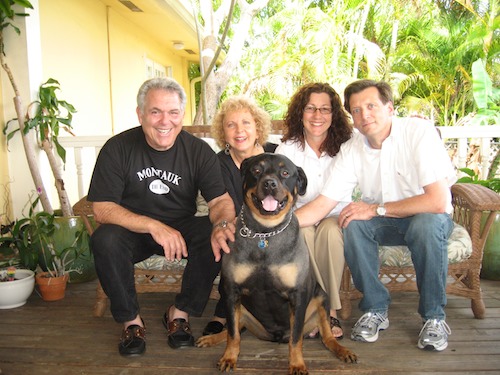George is one lucky dog–a dead ringer for the handsome, beefy, square-faced Rottweiler in Good Dog, Carl, the children's book series. He eats organic food, drinks purified water, and spends most weekdays with his canine cronies at Bark Avenue, a plush spa in Hollywood, Florida. Big deal, you say; many pets are pampered nowadays. But of the 77.5 million “owned” dogs in the U. S., how many have the run of two homes and four doting parents?
Life wasn’t always so good for George. The day he wandered onto Marianne and Ed Johnston’s circular driveway on Washington Street, he was dirty, his ribs stuck out, he had fleas, an ear infection, and a limp.
“You don’t see many loose dogs in our neighborhood,” Marianne explains, “and he was big.” Seeing him near her white Camry, Ed’s 75-year-old mother ran back into the house.
“I escorted my mother to the car,” Ed recalls, “and I was left with this big dog,” He knelt down and gently coaxed the dog into backyard and closed the gate. Then he called his next-door neighbors, Ron and Sherry Funt, who owned Bark Avenue.
The Johnstons and Funts, couples on the far side of middle age, had been neighbors for more than seven years. At that point, they had breakfast together almost every morning and spent many evenings playing Rummy Q. They had each others’ keys and alarm codes.
They also shared Beauty and Baby, cats the Funts had adopted from the former owners of the Johnstons’ house. The cats naturally thought both homes were theirs, and the humans fell easily into joint custody.
It didn’t seem like a big leap, then, for the four of them to decide that they’d split the cost and care of the dog until they could find his rightful owners.
“I don’t think any of us knew we were going to keep him at first,” recalls Marianne, “but I definitely didn’t want a dog.” And yet, within weeks, he had an official name–Sir George Washington (for their street) Funtston–a melding of their two last names. They spent time and energy and thousands of dollars in vet bills and food.
And even though they still considered it a “temporary” arrangement, within a month they’d agreed to invest another $800 in obedience training. The trainer found that George responded best to commands in German. The dog also cowered at the wave of a leash, a possible sign of abuse. In all probability, the trainer said, George had been dumped.
Rather than risk his being euthanized at a shelter, where a big dog with a murky past is often passed over, the foursome took it upon themselves to place George. But no one was “good enough”–no yard, too many kids, liked the husband but not the wife. After six months, even Marianne gave in: “Enough time had gone by that I trusted him, and Ron and Ed were soooo in love with him. And he really was a sweet dog.”
For the last three years, George has spent week days at the Johnstons and weekends with the Funts. Marianne, the in-charge mom, is the practical one. She’s quick to talk about George’s accidents, the slobber on the windows, the hair on her tile floors, while Sherry is more circumspect, preferring to stress how “organic” and “flexible” their co-parenting arrangement is.
Neither woman is as George-centric as her husband. Ed is the one George listens to best, and Ron is the playful dad who gets down on the floor to wrestle and smooch with him.
“They’re the doting parents,” says Sherry. “They love how macho he is.”
The “boys” feed him; the “girls” clean up after him. All decisions are discussed and made jointly–except the time Marianne unilaterally decided to shear George. After the other three got over the shock (“He looked like a seal,” Ron recalls), they conceded that it did, in fact, minimize the shedding.
“It wouldn’t work without everyone’s cooperation,” says Marianne, who grants that George’s weekday visits to Bark Avenue–have also helped. (Ron recently sold the facility but made sure that lifetime daycare was part of the deal.)
Sherry hopes their success will inspire a trend in pet-sharing: “It’s a way of creating community.” Country folk raise barns together. Why can’t good neighbors raise dogs together? The humans reap the unparalleled benefits of having a canine best friend and yet have only half the burden.
Indeed, by saving George’s life, the “Funtsons” seem to have unwittingly bettered their own.
Postscript, December 13, 2011: This is an email from Sherry Funt: "…as many of you know, our beloved George has been battling cancer for the past several months. His response to the chemo was somewhat miraculous. He went from not eating and listless, to running and playing, picking up his ball and bringing it for us to throw. It warmed our hearts to see the old George back in action. Last night George went to sleep, but didn't wake up. He passed in his sleep, pain free, in our home and with a great day previously together. It must have been his heart that gave out because he was cancer free.









